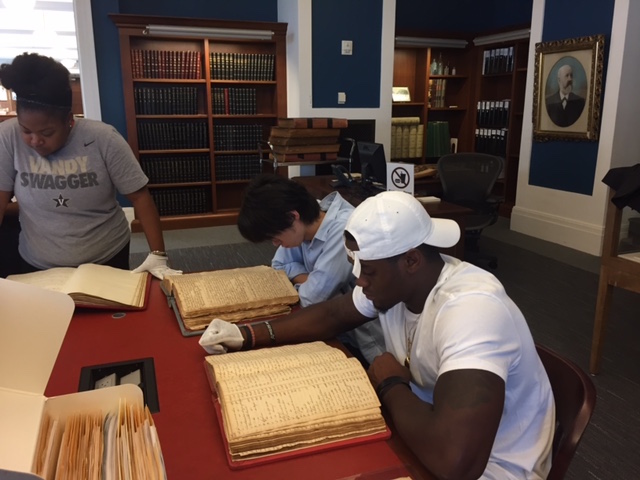Home » Historic Black Nashville » Metro Archives Site Visit
Metro Archives Site Visit
Posted by anderc8 on Wednesday, December 7, 2016 in Historic Black Nashville, News.

In September, the students of Historic Black Nashville visited the Metro Archives at the Nashville Public Library in downtown Nashville to conduct immersive research by reviewing texts, newspapers and other documents from the 1800s. A sampling of student-penned blog posts can be found below.
Kamala Varma
Freshman
Major undeclared
Many of the slave-related documents [at the Metro Archives] were utterly new and alien to me. When looking through an old farm journal, [I saw] pages of various lists, and some were clearly recognizable as names. However, I lacked the context to know the significance of the names and the lists. It is interesting, though, that these records that the masters (I assume) kept of the slaves were so minimal. It is hard for me to understand the point of keeping records so minimal and spare, for example, listing just a first name and an age. I am curious to know exactly the purpose of this journal—of this kind of minimal record—and to see other variations.
Part of the problem is that I have been educated to expect textbooks and teachers to deliver a spiel already tailored to a modern mind like mine. Despite the challenge, the idea of uncovering history less explored, and of having the freedom to chart the exploration on my own is exciting. The trip to the archives inspired my interest in beginning research for my final paper. I will definitely be making more trips. . . .
Reflecting on my trip, I realized how amazing it was to be looking at and touching (through gloves) genuine, first-hand archival objects. The farm journal, for example, was once held by a slave owner and, after many years, was touched by my own hands. I understand that it is important to connect with the past in this way. This is another reason why I am willing to skip the textbooks and museum panels, and to struggle through decoding the complex handwriting in which they are rendered: to directly access the true heart of the history these artifacts contain.
Kyla Stevens
Junior
EHST major
I enjoyed going through newspaper articles because it showed the type of media that was put out for everyone to see. There would be articles about killing slaves and slave ads, and it showed how normal slavery was to everyday life. People were not ashamed of it nor were they trying to hide it. The newspapers would also talk about some black people in a friendly manner. There were many articles celebrating the birthdays of slaves that were 80-100 years old, honoring them for their many years of service. To me this seemed as if blacks were only treated with some form of respect if they were thought to be complacent and not have any inkling of wanting to disrupt the hierarchy. For a black person to be submissive to a white for over 80 years of life was the ultimate goal of the white race.
I also found it interesting to look at the old maps of Nashville. You could see the divide between black and white Nashville and how many of the old streets and landmarks are still here today. It gives me a connection to the past and shows that many of the events that we are studying did not happen all that long ago.
Trent Sherfield
Junior
MHS major
While in the archives I ran across a book that caught my attention for the rest of the time there. The book had records of slaves that were bought from other states to be brought to Nashville to work. These slaves were paid a lot of money for the work that they did, which was building houses, courtrooms, etc. It was said that the money they earned would buy their freedom or their families’ freedom. The thing that was most interesting to me about this book was how they described the slaves that were being bought. They were described by their height, skin tone, what marks they had on their bodies, etc. When I was reading the descriptions of the slaves it made me picture each and every individual that was talked about in the book. One in particular that I remember was a man who was 6 feet tall, and was built very big. He had some scars on him, and he was one of the highest paid individuals in the entire book. The reason I paid attention to that description so much was because most of the men in the book were very short and he was the tallest. I imagine that he was paid the highest amount because of his height and the stature of his build. This made me think . . . about . . . the mindset of those men, who were working so hard for the money that they desperately needed. I imagine in my head one of those men being pushed to their very last limit, and about to give up; but he thinks about his family or his freedom that he wants, and continues to work. . . . I also imagine . . . how the slaves that worked to build the buildings for Nashville, went back to where they were originally from and [bought] their freedom. I thought about the joy that they must have felt to buy their, or their families’ freedom. This trip was something that I’ll never forget and it was very eye opening for me as well.

©2026 Vanderbilt University ·
Site Development: University Web Communications